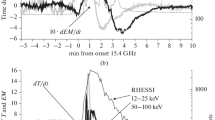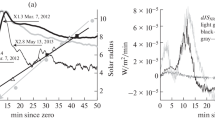Abstract
For a coronal mass ejection (CME) to occur, the magnetic pressure of the overlying layers must be lower than that of the underlying layers, and the corresponding Alfvén velocities must be equal. An interplanetary CME (ICME) must have at least the velocity of a quiet solar wind at the critical point. The maximum possible CME velocity is defined by the local Alfvén velocity. Based on the kinematics, the minimum CME acceleration rate is ~0.01 km/s2 and, accordingly, the maximum time of acceleration is ~6 h. The expected maximum acceleration rate, ~10 km/s2, sets the minimum time of acceleration at >1 min. The subsequent flares unaccompanied by ICMEs and solar proton events are studied: an M2.9 flare on July 6, 2012; an X1.6 flare on October 22, 2014; and an X2.2 flare on September 6, 2017. In all three flares, the energy is released within a region limited by the conditions for radiation generation at a plasma frequency of 1.415 GHz, which corresponds to the minimum electron concentration in it. This imposes a constraint on the magnetic field necessary for the realization of long-duration or fast CME acceleration regimes, >15 G or >200 G, respectively. Moreover, in the studied events, the size of the acceleration region is still not enough for an ICME to occur. Near the Earth, the EPHIN/SOHO observations show an excess over the background electron fluxes of <700 keV on October 22, 2014, and <10 MeV on September 6, 2017, for 20–30 min after the impulsive phase. In these cases, one cannot exclude the possibility of the stochastic acceleration of <10 MeV protons, which have left no traces in the solar atmosphere and have been invisible in interplanetary space.



Similar content being viewed by others
REFERENCES
Altyntsev, A., Meshalkina, N., Myshyakov, I., et al., Flare SOL2012-07-06: on the origin of the circular polarization reversal between 17 GHz and 34 GHz, Sol. Phys., 2017, vol. 292, no. 9, pp. 137–152.
Aschwanden, M.J., Physics of the Solar Corona: An Introduction with Problems and Solutions, Springer, 2009.
Cane, H.V., McGuire, R.E., and von Rosenvinge, T.T., Two classes of solar energetic particle events associated with impulsive and long-duration soft X-ray flares, Astrophys. J., 1986, vol. 301, pp. 448–459.
Cliver, E.W., History of research on solar energetic particle (SEP) events: The evolution paradigm, in Universal Heliophysical Processes: Proceedings of the IAU Symposium S257, International Astronomical Union, 2009, pp. 401–412.
Cliver, E.W., Kahler, S.W., Kazachenko, M., and Shimojo, M., The disappearing solar filament of 2013 September 29 and its large associated proton event: Implications for particle acceleration at the Sun, Astrophys. J., 2019, vol. 877, p. 11.
Filippov, B., Golub, L., and Koutchmy, S., X-ray jet dynamics in a polar coronal hole region, Sol. Phys., 2009, vol. 254, pp. 259–269.
Green, L.M., Török, T., Vršnak, B., et al., The origin, early evolution and predictability of solar eruptions, Space Sci. Rev., 2018, vol. 214, p. 46.
Grigis, P.C. and Benz, A.O., Spectral hardening in large solar flares, Astrophys. J., 2008, vol. 683, pp. 1180–1191.
Grigor’eva, I.Yu., Struminskii, A.B., and Shakhovskaya, A.N., Prolonged, weak C1.2 flares: A source of protons and electrons, Geomagn. Aeron. (Engl. Transl.), 2020, vol. 60, no. 6, pp. 710–719.
Guidice, D.A., Cliver, E.W., Barron, W.R., and Kahler, S., The Air Force RSTN system, Bull. Am. Astron. Soc., 1981, vol. 13, p. 553.
Hudson, H.S., Ion energy storage for post-flare loops, in Proc. Int. Cosmic Ray Conf., 1985, vol. 4, pp. 58–61.
Kiplinger, A.L., Comparative studies of hard X-ray spectral evolution in solar flares with high-energy proton events observed at Earth, Astrophys. J., 1995, vol. 453, pp. 973–986.
Klein, K.-L. and Dalla, S., Acceleration and propagation of solar energetic particles, Space Sci. Rev., 2017, vols. 3–4, pp. 1107–1140.
Lin, R.P., Dennis, B.R., Hurford, G.J., et al., The Reuven Ramaty High-Energy Solar Spectroscopic Imager (RHESSI), Sol. Phys., 2002, vol. 210, nos. 1–2, pp. 3–32.
Liu, L., Cheng, X., Wang, Y., et al., Rapid buildup of a magnetic flux rope during a confined 2. 2 class flare in NOAA AR 12673, Astrophys. J., 2018, vol. 867, p. L5.
Masson, S., Pariat, E., Aulanier, G., and Schrijver, C.J., The nature of flare ribbons in coronal null-point topology, Astrophys. J., 2009, vol. 700, p. 559.
Masson, S., Antiochos, S.K., and DeVore, C.R., Escape of flare-accelerated particles in solar eruptive events, Astrophys. J., 2019, vol. 884, p. 143.
Meshalkina, N.S., Uralov, A.M., Grechnev, V.V., et al., Eruptions of magnetic ropes in two homologous solar events of 2002 June 1 and 2: A key to understanding an enigmatic flare, Publ. Astron. Soc. Jpn., 2009, vol. 61, pp.791–803.
Miller, J.A., Cargill, P.J., Emslie, A.G., et al., Critical issues for understanding particle acceleration in impulsive solar flares, J. Geophys. Res., 1997, vol. 102, pp. 14631–14660.
Müller-Mellin, R., Kunow, H., Fleißner, V., et al., COSTEP—Comprehensive Suprathermal and Energetic Particle Analyser, Sol. Phys., 1995, vol. 162, nos. 1–2, pp. 483–504.
Pariat, E., Antiochos, S.K., and DeVore, C.R., A model for solar polar jets, Astrophys. J., 2009, vol. 691, pp. 61–74.
Parker, E.N., Dynamics of the interplanetary gas and magnetic fields, Astrophys. J., 1958, vol. 128, pp. 664–676.
Rieger, E., Treumann, R.A., and Karlicky, M., Radio-silent start of an intense solar gamma-ray flare, Sol. Phys., 1999, vol. 187, no. 1, pp. 59–75.
Schanne, S., Pre-launch calibration campaign of the gamma-ray spectrometer aboard the INTEGRAL satellite Show affiliations, New Astron. Rev., 2002, vol. 46, nos. 8–10, pp. 605–609.
Schanne, S., Cordier, B., and Gros, M., et al., The space-borne INTEGRAL-SPI gamma ray telescope: Test and calibration campaigns, IEEE Trans. Nucl. Sci., 2002, vol. 49, no. 3, pp. 1226–1232
Struminskii, A.B., Grigor’eva, I.Yu., Logachev, Yu.I., and Sadovskii, A.M., Solar electrons and protons in the events of September 4–10, 2017 and related phenomena, Plasma Phys. Rep., 2020a, vol. 46, no. 2, pp. 174–188.
Struminsky, A.B., Logachev, Yu.I., Grigor’eva, I.Yu., and Sadovski, A.M., Two phases of solar flares and a stochastic mechanism for acceleration of electrons and protons, Astrophysics, 2020b, vol. 63, no. 3, pp. 388–398.
Struminsky, A.B., Logachev, Yu.I., Grigor’eva, I.Yu., and Sadovski, A.M., Two types of gradual events: Solar protons and relativistic electrons, Geomagn. Aeron. (Engl. Transl.), 2020c, vol. 60, no. 8, pp. 1057–1066.
Sun, X., Bobra, M.G., Hoeksema, J.T., et al., Why is the great solar active region 12192 flare-rich but CME-poor?, Astrophys. J. Lett., 2015, vol. 804, no. 2, p. 804.
Thalmann, J.K., Su, Y., Temmer, M., and Veronig, A.M., The confined X-class flares of solar active region 2192, Astrophys. J., 2015, vol. 80, p. L23.
Zou, P., Jiang, C., Feng, X., et al., A two-step magnetic reconnection in a confined X-class flare in solar active region 12673, Astrophys. J., 2019, vol. 870, p. 97.
Zou, P., Jiang, C., Wei, F., et al., Continuous null-point magnetic reconnection builds up a torus unstable magnetic flux rope triggering the X9.3 flare in solar AR 12673, Astrophys. J., 2020, vol. 890, p. 10.
ACKNOWLEDGEMENTS
We thank the reviewer for carefully reading the manuscript and providing valuable remarks, comments, and suggestions. We are grateful to the participants of ground-based and space experiments, the data of which are available in the public domain and were used in this work (GOES, RSTN, ACS SPI, RHESSI, SOHO EPHIN, and SOHO LASCO).
Funding
The work by I.Yu. Grigor’eva (Pulkovo Astronomical Observatory) was supported by the “Energy Release” program. The work by A.B. Struminskii (Space Research Institute) was supported by the “Plasma” program.
Author information
Authors and Affiliations
Corresponding author
Ethics declarations
The authors declare that they have no conflicts of interest.
Additional information
Translated by A. Kobkova
This paper is published as a basis for discussion.
Rights and permissions
About this article
Cite this article
Grigor’eva, I.Y., Struminsky, A.B. Flares Unaccompanied by Interplanetary Coronal Mass Ejections and Solar Proton Events. Geomagn. Aeron. 61, 1263–1273 (2021). https://doi.org/10.1134/S0016793221080090
Received:
Revised:
Accepted:
Published:
Issue Date:
DOI: https://doi.org/10.1134/S0016793221080090




